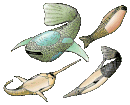| Pteraspidomorphi Temporal range:
| |
|---|---|

| |
| Pteraspis | |
| Scientific classification | |
| Domain: | Eukaryota |
| Kingdom: | Animalia |
| Phylum: | Chordata |
| Infraphylum: | Agnatha |
| Class: | †Pteraspidomorphi Goodrich, 1909 |
| Type species | |
| Pteraspis rostrata Agassiz, 1835
| |
| Subgroups[1] | |
| |
Pteraspidomorphi is an extinct class of early jawless fish. They have long been regarded as closely related or even ancestral to jawed vertebrates, but the few characteristics they share with the latter are now considered as basal traits for all vertebrates.
YouTube Encyclopedic
-
1/2Views:3 0346 570
-
Urzeitcode / UrcodeTeil2/2 (Urfische)
-
Dawn Of Man
Transcription
Characteristics

Pteraspidomorphs are characterized by their massive dermal head armour having large, median, ventral and dorsal plates or shields.[2]
The fossils show extensive shielding of the head. Many had hypocercal tails in order to generate lift to increase ease of movement through the water for their armoured bodies, which were covered in dermal bone. They also had sucking mouth parts and some species may have lived in fresh water.
Most pteraspidomorphs were marine, but lived very near to the shore, in lagoons and deltas. Some groups are thought to have been fresh water-dwelling. They were certainly bottom-dwellers, as shown by traces of abrasion of the ventral surfaces of their headshields.
Classification
Pteraspidomorphs have been first regarded as related to bony fishes, then to sharks, then ancestral to hagfishes, and finally as the closest jawless relatives of the gnathostomes.
This last theory was based on the fact that they seem to have a paired olfactory organ and a sensory-line pattern which is quite similar to that of the gnathostomes. These characteristics are, however, likely to be general for either the vertebrates or, at any rate, for the ensemble of all ostracoderms and the gnathostomes. Other ostracoderms, such as the Galeaspida are now known to have a paired olfactory organ. Current phylogenetic analysis using a large number of characteristics now place pteraspidomorphs as the sister-group of all other ostracoderms and the gnathostomes.
Phylogeny
Based on the work of Mikko Haaramo.[3]
| Pteraspidomorphi |
| ||||||||||||||||||||||||||||||||||||||||||||||||
See also
References
- ^ "Pteraspidomorphi". After Carroll, 1988, and Janvier, 1997. Retrieved 26 October 2013.
- ^ Janvier, Philippe (1997) Pteraspidomorphi The Tree of Life Web Project.
- ^ Haaramo, Mikko (2007). "†Pteraspidomorphi". Mikko's Phylogeny Archive. Retrieved 30 December 2016.
External links
- Pteraspidomorphi at Tolweb
- Pteraspidomorphi at Palaeos







